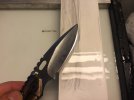Though the years I have tried different methods of sharpening .. usually with poor results. Like most people, I have been slowly trying different methods to improve my sharpening skills.
I finally ended up with the Worksharp and a belt grinder (using different grits). I get very good results with both of those devices and in the process learned about the burr etc.
I have started hand sharpening some kitchen knives using the Norton course and fine stone with pretty good results. I have been enjoying the hand sharpening. My hand sharping is improved so I would like to get some very good stones to make my ability and not the stones the limiting factor. I would transition to just using the stones for sharpening.
I also have some more difficult steels to sharpen (D2, Elmax, M390, S110v, etc) so I would like a stone that would work with my normal kitchen knives and also these steels. Because of that, I have been reading and think the DMT or the Shapton Glass may work. I would like to get "push" cutting results.
I have never had a nice polished edge but I am more interested in a sharp knife then the looks of the blade. However, a polished edge would also be a plus. My research (searching posts) has lead me to DMT or Shapton Glass stones as a possible solution.
The DMT stones seem attractive since they can handle any steel.. it sounds like the major disadvantage would be the scratch patterns and fininishing the edge to a polished look. Many people seem to use a different stone of some kind to polish the edge.
The Shapton stones have the polished edge but I am not sure if they work well with the more difficult steels.
What are your thoughts or these stones or would you recommend something else?
Could you recommend the grits in each to get me to a nice edge? I would like to make the correct purchase.
Thanks!
I finally ended up with the Worksharp and a belt grinder (using different grits). I get very good results with both of those devices and in the process learned about the burr etc.
I have started hand sharpening some kitchen knives using the Norton course and fine stone with pretty good results. I have been enjoying the hand sharpening. My hand sharping is improved so I would like to get some very good stones to make my ability and not the stones the limiting factor. I would transition to just using the stones for sharpening.
I also have some more difficult steels to sharpen (D2, Elmax, M390, S110v, etc) so I would like a stone that would work with my normal kitchen knives and also these steels. Because of that, I have been reading and think the DMT or the Shapton Glass may work. I would like to get "push" cutting results.
I have never had a nice polished edge but I am more interested in a sharp knife then the looks of the blade. However, a polished edge would also be a plus. My research (searching posts) has lead me to DMT or Shapton Glass stones as a possible solution.
The DMT stones seem attractive since they can handle any steel.. it sounds like the major disadvantage would be the scratch patterns and fininishing the edge to a polished look. Many people seem to use a different stone of some kind to polish the edge.
The Shapton stones have the polished edge but I am not sure if they work well with the more difficult steels.
What are your thoughts or these stones or would you recommend something else?
Could you recommend the grits in each to get me to a nice edge? I would like to make the correct purchase.
Thanks!

